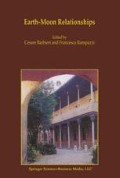Abstract
During the latter part of the last century, a profound change took place in our perception of the Earth. First, this change was holistic: Plate tectonic theory provided a unifying theme that seems to explain disparate observations about the Earth and how it works, and lets us see the Earth as a planet. Secondly, actually seeing the Earth from the Moon, and exploring the other planets provided additional perspectives on our own home planet and hastened the decline of scientific terracentrism. Thirdly, learning that the uniqueness of the Moon in terms of size and aspects of its chemistry may be due to its derivation from the Earth as the result of a giant impact, provided a concrete filial link. Finally, the geological record revealed by exploration of the Moon and planets has provided us with the missing chapters in the dynamic history of the Earth. We now know that gargantuan impact basins formed in Earth’s formative years and that impact events are likely to be the cause of many punctuations in Earth’s biological evolution. Perspectives on ancient tectonic activity are provided by Mercury, Venus, Mars, and the Moon, and show that the Earth has changed considerably since its youth. Widely varying volcanic eruption styles are seen on the planets, providing insight into how puzzling rocks from early Earth history formed. The composition of planetary atmospheres has revealed the unusual nature of Earth’s, and its link to the evolution of life. The atmospheres of the planets have undergone radical changes with time, providing clues to Earth’s history and destiny. Fundamentally different hydrological cycles on Earth, Venus, Europa and Mars, and evidence for significant changes with time, have provided insight into Earth’s history. The probable presence of oceans on Europa and Mars has changed our thinking about the origin and evolution of life on Earth. We no longer think of the Earth in isolation. Instead, Earth is now perceived of as a member of a family of planets, each of which provides important missing information and perspective on the other, and together reveal the fabric of the history of the Solar System. Future exploration and perspectives will place our Solar System in the context of all of the others.
Access this chapter
Tax calculation will be finalised at checkout
Purchases are for personal use only
Preview
Unable to display preview. Download preview PDF.
Selected Readings
Allegre, C.: 1992, From Stone to Star, A View of Modern Geology, Harvard University Press, CT.
Alvarez, W.: 1997, T. Rex and the Crater of Doom, Princeton University Press, Princeton.
Beatty, J. K., Petersen, C. C., and Chaikin, A. (eds): 1999, The New Solar System, Sky Publishing Corporation, Cambridge, MA.
Boorstein, D. J.: 1983, The Discoverers, Random House, New York.
Chaikin, A.: 1994, A Man on the Moon, Viking Press, New York.
Ciba Foundation: 1996: Evolution of Hydrothermal Ecosystems on Earth (and Mars?), John Wiley & Sons Ltd, West Sussex.
Goldsmith, D.: 1997, Worlds Unnumbered: The Search for Extrasolar Planets, University Science Books, Sausalito, CA.
Goldsmith, D.: 1997, The Huntfor Life on Mars, Penguin, New York.
Greeley, R.: 1993, Planetary Landscapes, Chapman & Hall, New York.
Grinspoon, D. H.: 1997, Venus Revealed: A New Look below the Clouds of Our Mysterious Twin Planet, Addison-Wesley, Reading, MA.
Harland, D. M.: 1999, Exploring the Moon: The Apollo Expeditions, Springer Praxis, London.
Hartmann, W. K.: 1993, Moons and Planets, Wadsworth, Belmont, CA.
Krupp, E. C.: 1983, Echoes of the Ancient Skies, Harper and Row, New York.
Light, M.: 1999, Full Moon, Alfred A. Knopf, New York.
MacKenzie, F. T.: 1998, Our Changing Planet: An Introduction to Earth System Science and Global Environmental Change, Prentice Hall, NJ.
McSween, H. Y.: 1995, Stardust to Planets: A Geological Tour of the Universe, St. Martin’s Griffin, New York.
Morrison, D. and Owen, T.: 1988, The Planetary System, Addison-Wesley Publishing Company, Reading MA.
Norton, O. R.: 1998, Rocksfrom Space, Mountain Press Publishing, Missoula, MT.
Oreskes, N.: 1999, The Rejection of Continental Drift: Theory and Method in American Earth Science, Oxford University Press, New York.
Sagan, C.: 1982, Cosmos, Random House, New York.
Shirley, J. H. and Fairbridge, R. W.: 1997, Encyclopedia of Planetary Sciences, Chapman & Hall, London.
Spudis, P. D.: 1996, The Once and Future Moon, Smithsonian Institution Press, Washington, DC.
Strom, R. G.: 1987, Mercury: The Elusive Planet, Smithsonian Institution Press, Washington, DC.
Ward, P. D. and Brownlee, D.: 2000, Rare Earth: Why Complex Life Is Uncommon in the Universe, Copernicus, New York.
Weissman, P. R., McFadden, L., and Johnson, T. V. (eds.): 1999, Encyclopedia of the Solar System, Academic Press, San Diego.
Wilhelms, D. E.: 1993, To a Rocky Moon: A Geologist’s History of Lunar Exploration, University of Arizona Press, Arizona.
Zebrowski, E.: 1997, Perils of a Restless Planet: Scientific Perspectives on Natural Disasters, Cambridge University Press, Cambridge.
Author information
Authors and Affiliations
Editor information
Editors and Affiliations
Rights and permissions
Copyright information
© 2001 Springer Science+Business Media New York
About this paper
Cite this paper
Head, J.W. (2001). Lunar and Planetary Perspectives on the Geological History of the Earth. In: Barbieri, C., Rampazzi, F. (eds) Earth-Moon Relationships. Springer, Dordrecht. https://doi.org/10.1007/978-94-010-0800-6_16
Download citation
DOI: https://doi.org/10.1007/978-94-010-0800-6_16
Publisher Name: Springer, Dordrecht
Print ISBN: 978-94-010-3855-3
Online ISBN: 978-94-010-0800-6
eBook Packages: Springer Book Archive

